Coronavirus Today: Graphing the pandemic
- Share via
Good evening. I’m Karen Kaplan, and it’s Wednesday, May 26. Here’s what’s happening with the coronavirus in California and beyond.
If a picture is worth a thousand words, what’s a chart worth? Plenty. This story by my colleagues Emily Baumgaertner and Terry Castleman has five of them, and they make it abundantly clear that although the pandemic appears to be waning in the United States, that’s certainly not the case everywhere.
Let’s examine some of their graphs, starting with this one that compares COVID-19 death rates around the world:
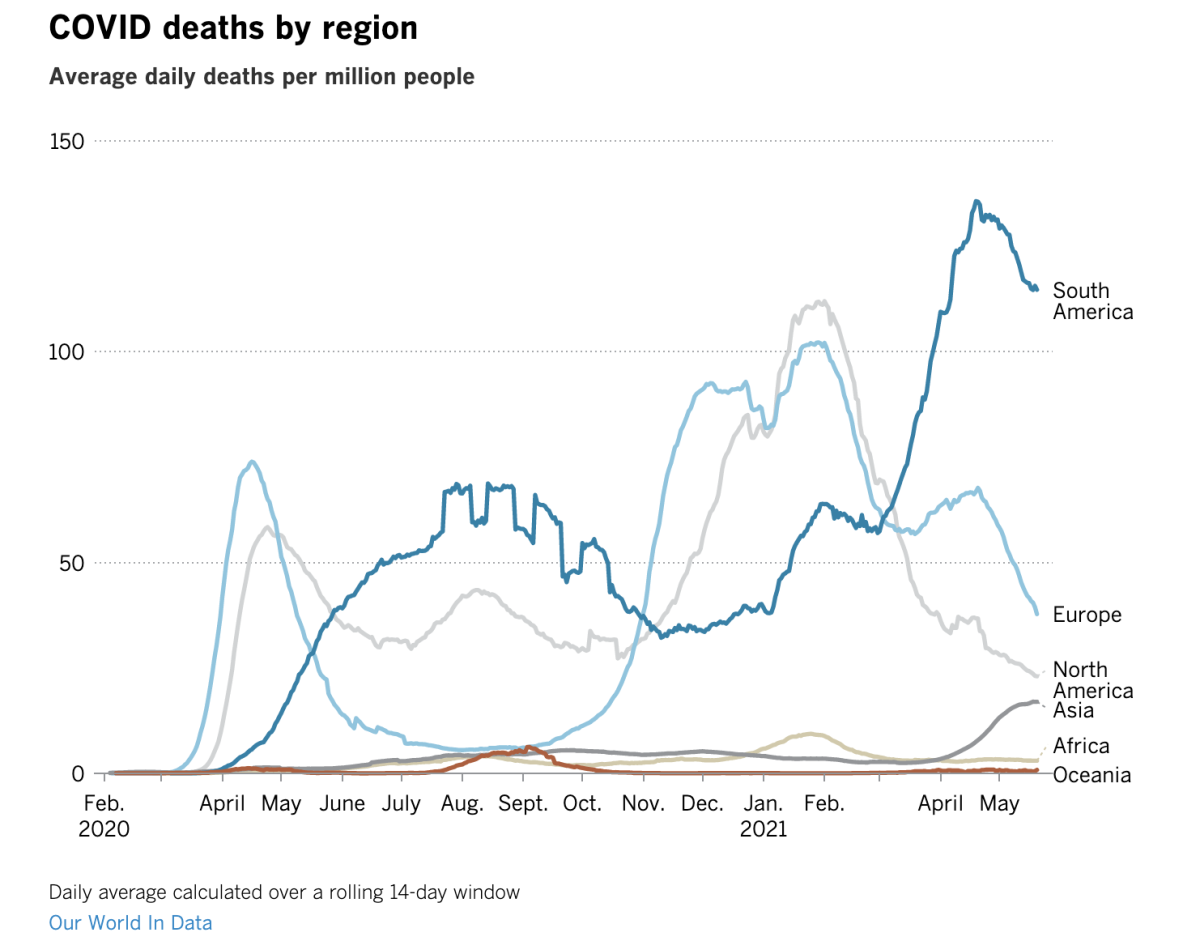
What this graph makes clear is that the pandemic is not affecting all parts of the world equally at any given time. When North America and Europe were in the midst of a devastating surge last fall and winter, most of the rest of the world was relatively calm. And while North America and Europe were finally seeing some relief, the situation was worsening in Asia and South America.
The outbreak in Asia is getting more attention now in part because of the controversy surrounding the upcoming Tokyo Olympics. But the real news is the extent of the crisis in South America. The death rate there over the last four weeks is far higher than for any other continent.
Lots of factors might help explain the differences, including the age and health of each population, vaccination rates, lockdown policies, the quality of medical care and — experts cautioned — widespread variation in how death statistics are collected.
In the case of South America, one very likely factor is the P.1 variant, which was first identified in Brazil in December but now circulates widely. It appears to spread more easily and quickly than some other strains.
Meanwhile, the death rate in Africa has been relatively low throughout the pandemic. Some epidemiologists speculated that the continent has been spared by its young population.
Experience is on Africa’s side too: Nations accustomed to massive disease outbreaks have been more proactive with lockdowns and other control measures. Sierra Leone and Liberia, both ravaged by the Ebola epidemic of 2014-16, have each reported fewer than 100 COVID-19 deaths.
Here’s a look at COVID-19 death rates by country:
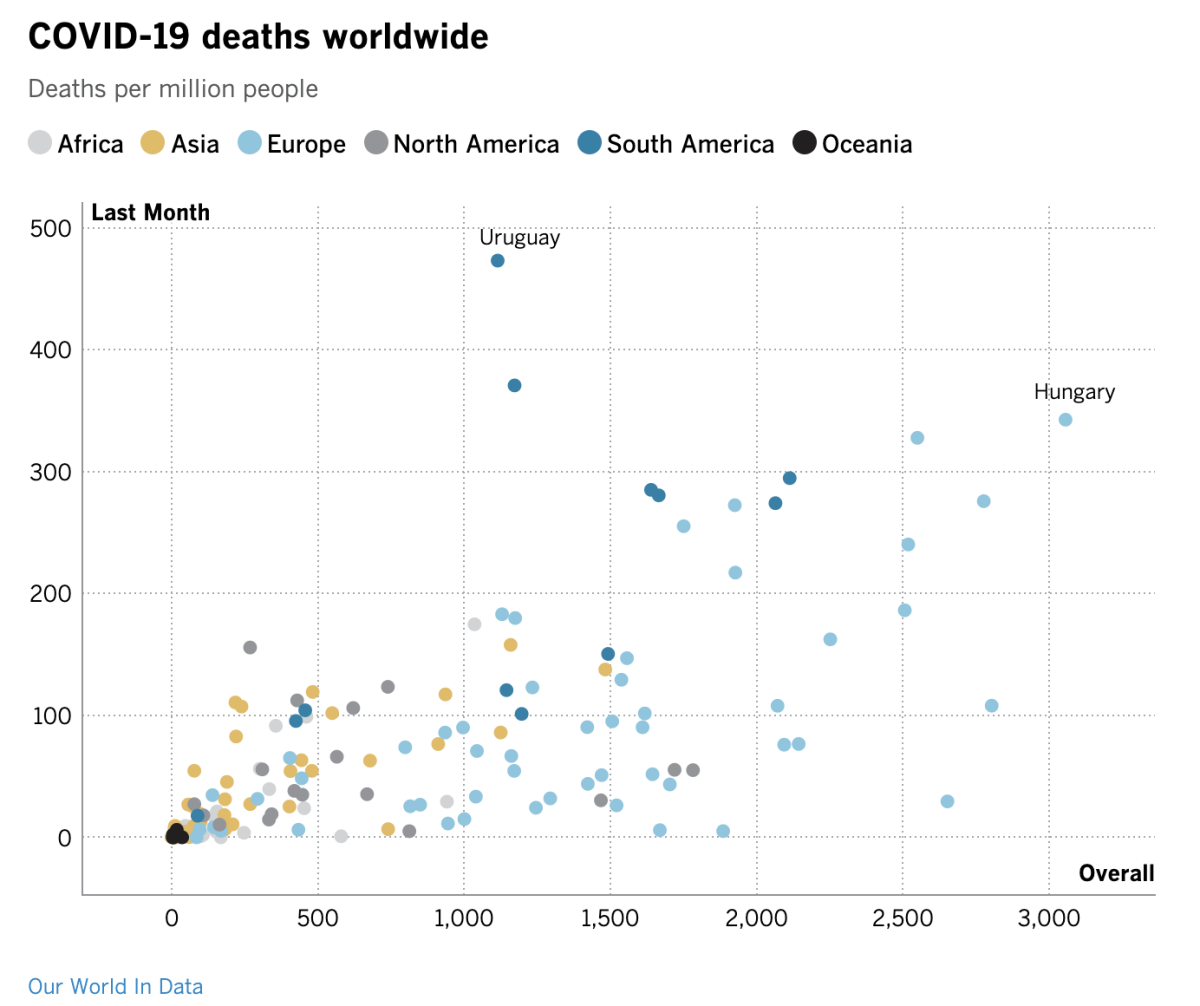
This plot shows how individual countries have fared, both lately and over the course of the pandemic. The higher a country appears on the graph, the higher its death rate over the last four weeks. The further it appears to the right, the higher its total death rate. (I encourage you to click through to the story — if you do, you can hover over the dots to find out which country each one represents.)
Consistent with the first graph, this one shows that no country has had suffered more in recent weeks than Uruguay. The dark blue dot just below it is Paraguay. Brazil, Argentina, Colombia and Peru are also way up there.
But the countries with the highest overall death rates are in Europe, mostly Eastern Europe. The dots to the right of the line for 2,500 deaths per 1 million people represent Hungary, Bosnia and Herzegovina, the Czech Republic, San Marino, North Macedonia, Bulgaria and Montenegro.
Eastern Europe had early success beating back the pandemic, as much of the region adopted strict lockdown policies last spring. Now experts think that history may have made its governments slower to react when a new wave of infections arrived. Eastern Europe surpassed Western Europe in terms of the overall death rate about two months ago and has been pulling away ever since. Indeed, no other region has a higher recorded death rate over the course of the pandemic.
Let’s look at one more graph, showing COVID-19 vaccinations over time:
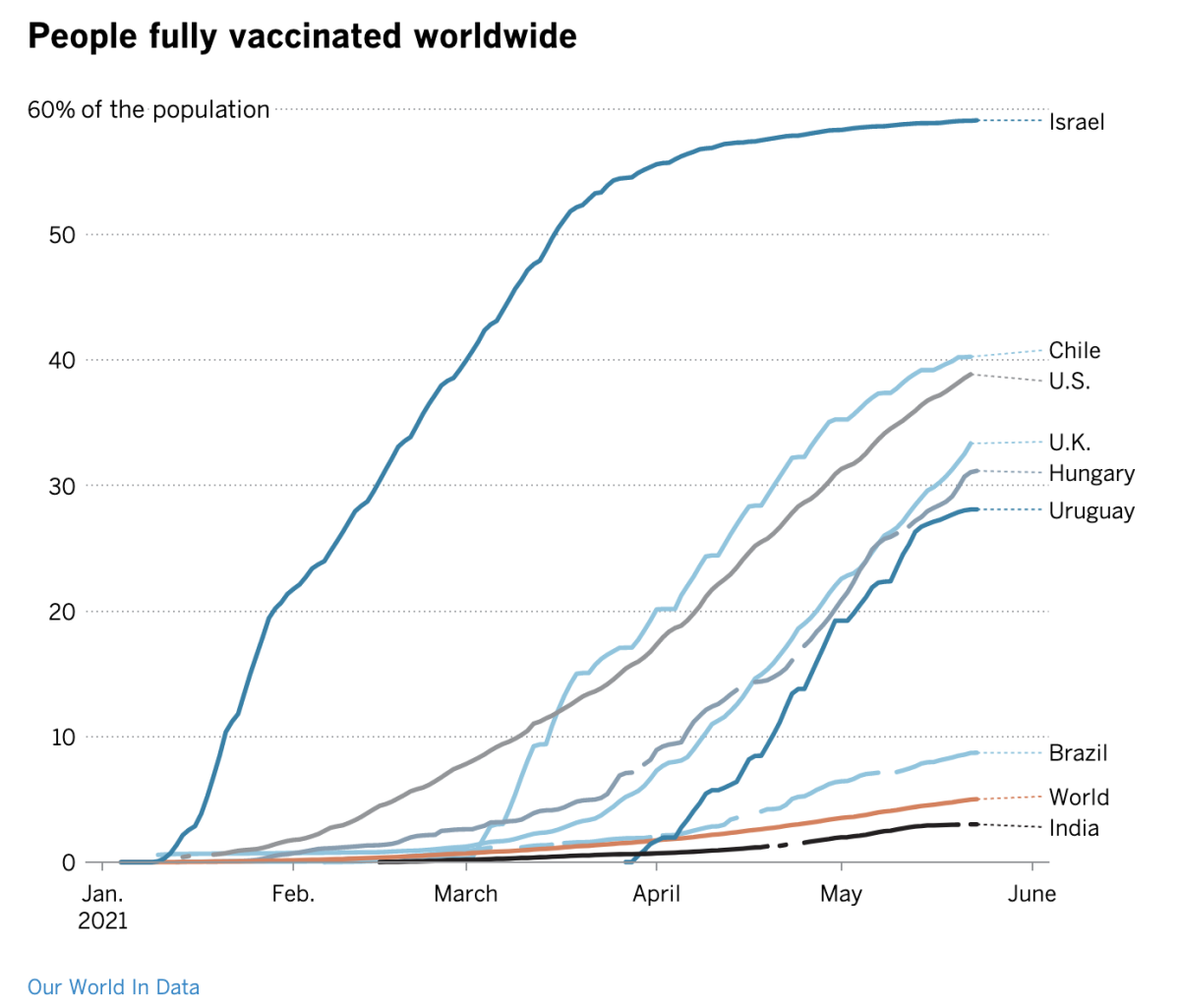
We’ve brought you stories in this newsletter about Israel’s aggressive vaccination campaign, and the things we’re learning about coronavirus immunity as a result of their experience. This graph makes it super clear why the country has been such a hotbed for that kind of research.
The shape of that curve also shows that no matter how eager some people are to get vaccinated, at some point you’ve got to start working harder to reach the last holdouts.
In the U.S., the collective outrage over people jumping the line to get vaccinated now seems like a distant memory, considering how hard health officials are working to persuade those on the fence to get vaccinated. But one thing this graph makes clear is how far behind the rest of the world is when it comes to immunizations.
How much are vaccines helping right now? Experts are reluctant to give them full credit for the low COVID-19 death rates here and in Western Europe. Many factors contributed to the springtime calm, including the absence of major holidays that are synonymous with large gatherings.
Also, both Uruguay and Hungary have relatively high vaccination rates — a fact that has researchers stumped.
India is noticeably below the anemic world average. Six months ago, the country appeared to be a COVID-19 success story; now its death rate is accelerating sharply. It’s a perfect example of just how unpredictable the coronavirus can be.
“We can evaluate things as they are now, and make judgments,” said Dr. Carlos del Rio, an infectious disease expert at Emory University School of Medicine. “But even when I see nice numbers like the ones in the U.S., I think to myself: I hope it stays that way.”
By the numbers
California cases, deaths and vaccinations as of 6:24 p.m.:

Track California’s coronavirus spread and vaccination efforts — including the latest numbers and how they break down — with our graphics.
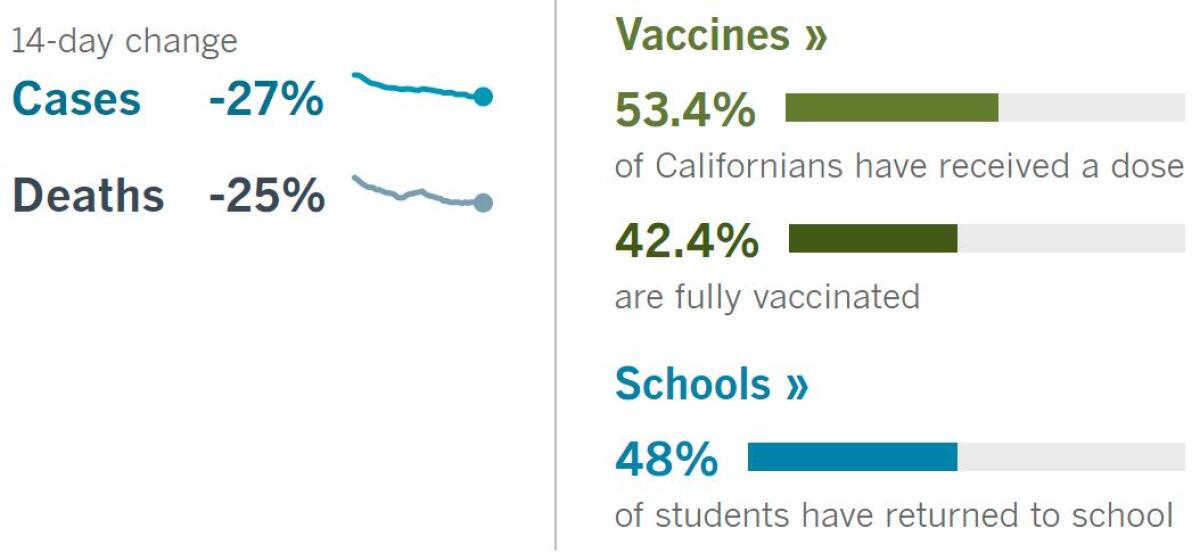
Across California
More than 36 million doses of COVID-19 vaccine have been administered statewide, and 53.4% of Californians have gotten at least one shot to date. But those shots haven’t been delivered equally throughout the state.
In fact, vast gulfs in inoculation rates have opened among California’s 58 counties, illustrating the state’s uneven pace toward achieving community immunity against the coronavirus.
On one end of the spectrum are the counties of Marin, Alpine, San Francisco, San Mateo, Santa Clara and San Diego, where more than 65% of each area’s residents have received at least one vaccine dose, according to data compiled by The Times.
On the other are Lassen, Tehama, Kings, Modoc and Yuba counties, where fewer than one-third of residents are even partially vaccinated.
Los Angeles County is in between, with 53% of residents at least partially vaccinated. So is Orange County, where nearly 55% have had at least one shot.
While a generally high statewide level of vaccination may be enough to ward off another devastating surge, health officials remain concerned that the coronavirus could still flare up in areas where coverage is low.
If people do get COVID-19, there’s a treatment that can significantly minimize the severity of COVID-19 and reduce the risk of death. But even though it’s available for free in San Diego County, too few people are taking advantage of it, officials say.
The treatment consists of monoclonal antibodies, which are able to pick off the coronavirus before it gets the chance to cause critical cases of COVID-19. Patients can get it at a county health department clinic in Chula Vista, one of California’s hardest-hit cities. But only 49 patients have received the two-drug cocktail in the last 30 days. Health officials expected higher demand, given that a similar arrangement in Escondido has dosed 247 patients.
A surge in fully vaccinated residents over the last few months probably contributed to an overall decrease in the use of monoclonals. After all, the more people who are vaccinated, the fewer COVID-19 patients there will be.
Still, San Diego has averaged 154 new positive coronavirus test results per day over the last two weeks, and hospitals continue to house more than 100 COVID-19 patients each day. The low treatment numbers indicate that many are not availing themselves of an option that could provide a significant benefit.
Doctors may be reluctant to refer their patients, thinking they’re not sick enough for the treatment, said Dr. Jennifer Tuteur, deputy chief medical officer for San Diego County. But you don’t have to be very sick to get the drugs: Studies show they’re most effective if given shortly after a positive test, while symptoms remain mild — generally headaches, a runny nose, a slight cough or fatigue.
Here’s a positive indicator about the coronavirus in California: The Disney theme parks in Anaheim have begun selling tickets to people from out of state for the first time since the pandemic forced them to close their doors more than a year ago.
Disneyland and Disney California Adventure plan to start admitting out-of-state visitors June 15, the day California is scheduled to loosen its pandemic restrictions on most businesses. Ticket sales and reservations for those dates are available now.
The parks, which have been open to California residents since April 30, will continue to require visitors to wear masks. But they won’t require proof of vaccinations or of negative coronavirus test results.
The move to welcome out-of-state visitors is significant because they tend to spend more money than locals — by booking hotel rooms, renting cars and staying for several days. SeaWorld in San Diego and Universal Studios Hollywood already admit out-of-state visitors. Six Flags Magic Mountain in Valencia and Knott’s Berry Farm in Buena Park haven’t yet taken that step.
Under the rules that take effect June 15, theme parks are classified as an “outdoor mega event” that accommodates more than 10,000 people. State health officials still consider such events a “higher risk for COVID transmission” and recommend that masks be worn by all attendees.
The guidelines also advise operators to verify that all attendees are fully vaccinated or show they tested negative for the coronavirus no more than 72 hours before attending.
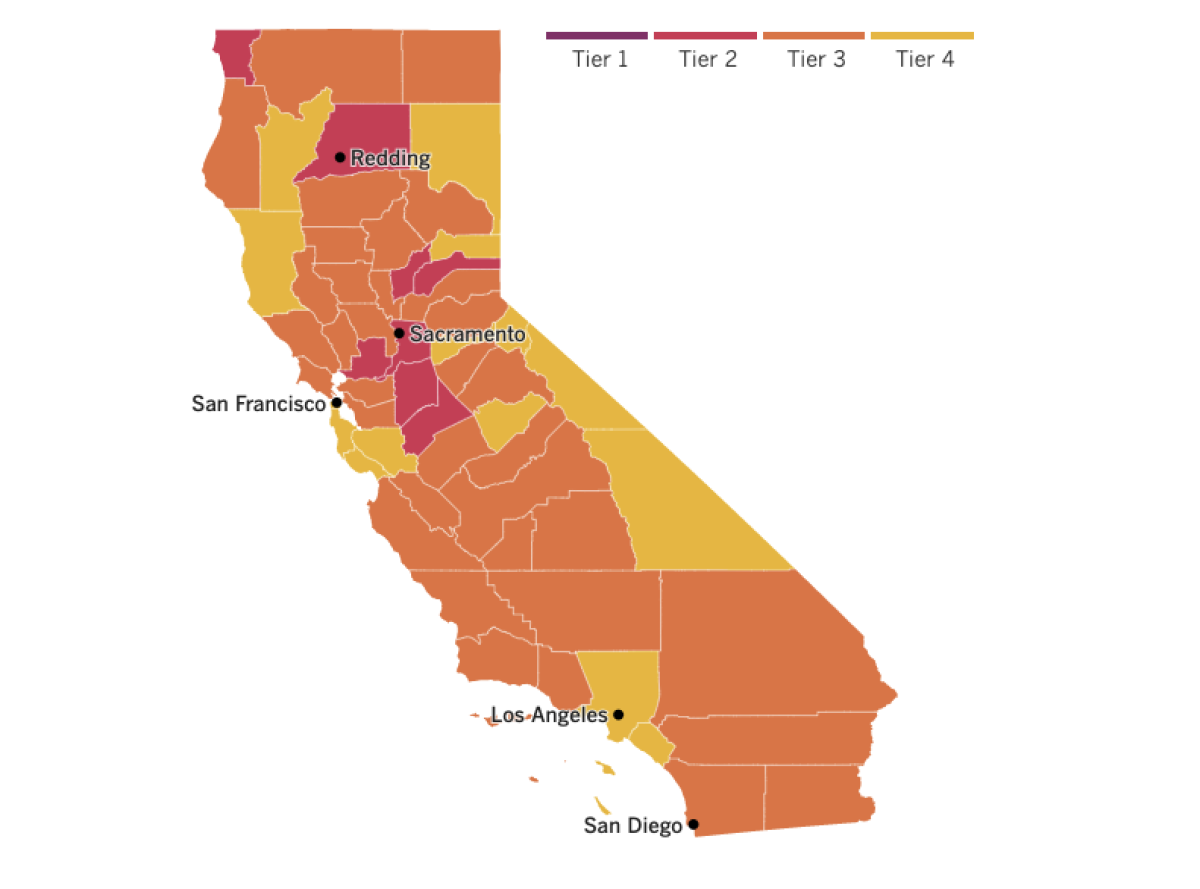

See the latest on California’s coronavirus closures and reopenings, and the metrics that inform them, with our tracker.
Consider subscribing to the Los Angeles Times
Your support helps us deliver the news that matters most. Become a subscriber.
Around the nation and the world
The hunt for the coronavirus’ origins heated up Wednesday as President Biden ordered U.S. intelligence agencies to intensify their effort to determine whether the pandemic could have begun with a lab accident in China. The directive was a rare public statement about an ongoing classified initiative, my colleagues Chris Megerian and Emily Baumgaertner report.
“I have now asked the intelligence community to redouble their efforts to collect and analyze information that could bring us closer to a definitive conclusion, and to report back to me in 90 days,” Biden said in his statement. He asked intelligence officials to keep Congress updated and work closely with government laboratories.
The coronavirus known as SARS-CoV-2 could have evolved naturally, percolating among wild animals before making the jump to humans. Bats in particular are known to harbor different strains of coronavirus. But scientists have yet to identify a wild animal with SARS-CoV-2.
That’s one reason scientists have been paying more attention to the idea that negligent workers at the Wuhan Institute of Virology could have played a role in seeding the pandemic. It’s unclear whether the virus was being studied there, but the lab has been known to gather coronavirus samples from high-risk environments, such as bat caves.
If the virus were indeed in the lab, workers could have been infected if they did not take sufficient safety precautions, such as wearing personal protective equipment. An infected worker could have brought the virus home and spread it to family members or others without even realizing it. State Department officials who visited the facility sent memos to Washington in 2018 expressing concern over unsafe laboratory practices there.
U.S. personnel were not allowed to visit Wuhan during the pandemic’s earliest stages last year, and a more recent inquiry by the World Health Organization was widely considered to have been undermined by the Chinese government’s restrictions on the work.
Meanwhile, schools across the U.S. are stepping up their efforts to get students vaccinated before summer vacation begins. With food trucks, prize giveaways and mascots in costumes, the atmosphere can seem more like a football pep rally than a medical clinic.
The nation’s 15 million kids ages 12 to 15 became eligible for the Pfizer-BioNTech vaccine about two weeks ago. So far, about 14% have received their first shot, according to the Centers for Disease Control and Prevention. The 7.5 million teens ages 16 and 17 have been eligible longer; 34% of them have received their first dose, and about 22% have had both shots.
In suburban Detroit, students in the Southfield district who show proof of vaccination will get a free ticket to the senior prom, a perk worth $80. The incentive drew criticism from those who said rewarding the vaccinated could lead to harassment of students who haven’t gotten shots.
Protesters have gathered outside schools offering the vaccine, discouraging kids who may already be nervous. But they don’t always find a receptive audience.
Laura Pilger, a student at Mission Bay High School in San Diego, said she feels safer being back in school knowing that she and everyone she knows is vaccinated. “A woman showed up and was passing out fliers that said, ‘Your body, your choice,’ but the message was not very welcomed,” Pilger said. “Why wouldn’t you want to get the vaccine?”
And finally, if it’s financial help you need, listen up: Time is running out for small-business owners looking to get a government Paycheck Protection Program loan.
Applications for the final round of PPP loans will be accepted only until Monday or until the remaining funds are drained, whichever is sooner.
Most of the money is already gone. As of Friday, only about $3 billion was left of the $800 billion provided for the program, according to congressional staff. The Small Business Administration has approved more than 11 million of the loans over the course of the program.
In these final few days, the SBA is offering PPP loans only through participating community financial institutions. Be sure to read this story by business reporter Samantha Masunaga if you’re looking to apply.
Your questions answered
Today’s question comes from readers who want to know: If you catch the virus, will you get less sick if you’re infected by a vaccinated person than by an unvaccinated person?
Perhaps. People who are vaccinated against COVID-19 are significantly less likely to spread the coronavirus than those who are not vaccinated, said Dr. David Lo, an immunologist at UC Riverside.
However, if a vaccinated person does spread the virus, that virus would be no different than whatever is already circulating in the community, he said.
Still, it’s possible that if a vaccinated person does spread the virus to an unvaccinated person, it could result in a milder case of COVID-19, he said.
“The severity of infection may be related to the amount of virus you got,” he said. “In the rare event that someone who was immunized does shed the virus, that shed may be so low that it may mean less severe disease.”
We want to hear from you. Email us your coronavirus questions, and we’ll do our best to answer them. Wondering if your question’s already been answered? Check out our archive here.
Resources
Need a vaccine? Sign up for email updates, and make an appointment where you live: City of Los Angeles | Los Angeles County | Kern County | Orange County | Riverside County | San Bernardino County | San Diego County | San Luis Obispo County | Santa Barbara County | Ventura County
Need more vaccine help? Talk to your healthcare provider. Call the state’s COVID-19 hotline at (833) 422-4255. And consult our county-by-county guides to getting vaccinated.
Practice social distancing using these tips, and wear a mask or two.
Watch for symptoms such as fever, cough, shortness of breath, chills, shaking with chills, muscle pain, headache, sore throat and loss of taste or smell. Here’s what to look for and when.
Need to get tested? Here’s where you can in L.A. County and around California.
Americans are hurting in many ways. We have advice for helping kids cope, resources for people experiencing domestic abuse and a newsletter to help you make ends meet.
We’ve answered hundreds of readers’ questions. Explore them in our archive here.
For our most up-to-date coverage, visit our homepage and our Health section, get our breaking news alerts, and follow us on Twitter and Instagram.




